SpartanNash Bundle
How well do you know the SpartanNash Company?
Journey back in time to discover the fascinating SpartanNash SWOT Analysis and the evolution of a food industry giant. From its humble beginnings in 1917 as a cooperative of Michigan retailers, SpartanNash has transformed into a major player in food distribution and retail. Explore the key milestones and strategic decisions that have shaped the SpartanNash company into the powerhouse it is today.
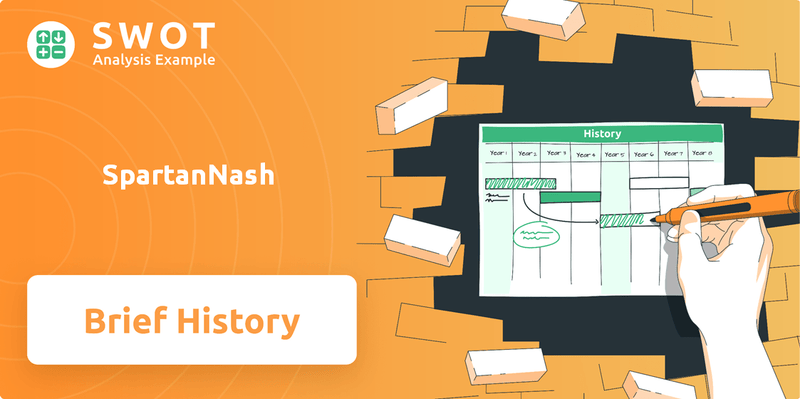
This exploration of SpartanNash history reveals a compelling narrative of adaptation and growth. Understanding the SpartanNash company background provides valuable insights into its business model, financial performance, and current operations. Learn about the SpartanNash impact on local communities and its significant role in the food distribution and grocery store sectors.
What is the SpartanNash Founding Story?
The story of the SpartanNash company is a tale of two companies merging to create a powerhouse in the food distribution and retail industries. This brief history of SpartanNash begins with the separate origins of Spartan Stores and Nash Finch Company, each with its own unique path but ultimately destined to converge.
Understanding the SpartanNash history requires looking at these two foundational entities. Their eventual union in 2013 formed the SpartanNash company we know today, a major player in the grocery store and food distribution sectors.
The roots of SpartanNash are deeply intertwined with the evolution of the grocery industry. Let's explore the founding stories of Spartan Stores and Nash Finch Company.
In 1917, a group of 100 independent retailers in Michigan joined forces to establish the Grand Rapids Wholesale Grocery Company. This marked the beginning of what would eventually become Spartan Stores. Their initial collective action involved purchasing a boxcar of sugar, a symbolic move demonstrating their commitment to group buying to benefit customers.
- This cooperative model was designed to help independent grocers compete more effectively with larger chains.
- The Grand Rapids Wholesale Grocery Company was officially incorporated in 1918, with 43 original retailers.
- This early focus on collaboration and bulk purchasing set the stage for the company's future growth.
- The company's success was driven by a need for efficient food distribution and retail solutions.
The Nash Finch Company's story began in 1885 when brothers Fred, Edgar, and Willis Nash opened a candy and tobacco shop in Devils Lake, North Dakota. The company expanded into fruit distribution and, in 1904, launched its private-label brand, 'Our Family,' which remains a key brand for SpartanNash today.
- Nash Finch grew through wholesale distribution and strategic acquisitions over time.
- The company became publicly traded in 1983.
- The company's growth was also shaped by the need for efficient food distribution.
- The merger of Spartan Stores and Nash Finch in 2013 created the SpartanNash of today.
Both Spartan Stores and Nash Finch Company were shaped by the economic conditions of their times, striving to provide effective food distribution and retail solutions. The merger of these two established companies in 2013 would create the SpartanNash of today. For more insights into the company's strategic direction, consider reading about the Growth Strategy of SpartanNash.
SpartanNash SWOT Analysis
- Complete SWOT Breakdown
- Fully Customizable
- Editable in Excel & Word
- Professional Formatting
- Investor-Ready Format
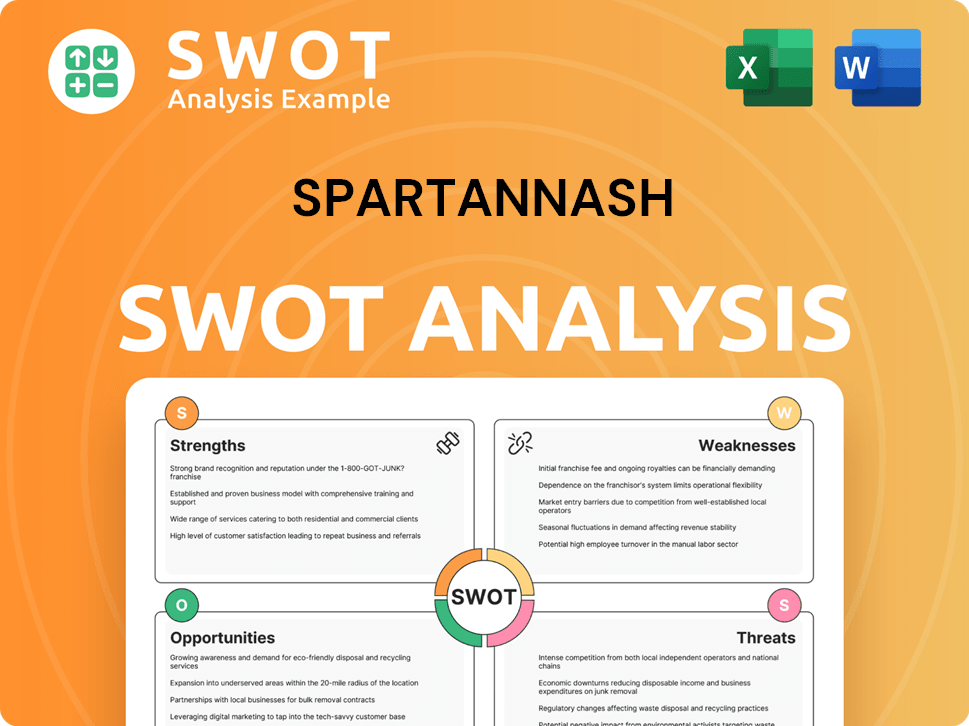
What Drove the Early Growth of SpartanNash?
The early growth of the SpartanNash company involved significant strategic shifts and acquisitions. Initially operating as a cooperative, the company transitioned to a for-profit structure in 1973, setting the stage for expansion. This period saw the SpartanNash history evolve through strategic acquisitions and a public listing, solidifying its position in the food distribution and retail sectors. The SpartanNash business model was built on both organic and inorganic growth.
In 1973, the Grand Rapids Wholesale Grocery Company, the foundation of what would become SpartanNash, changed from a cooperative to a for-profit entity. This transition was a pivotal moment, enabling the company to pursue more aggressive growth strategies. This shift allowed for greater flexibility in investments and acquisitions, setting the stage for future expansions in the Grocery store and Food distribution markets.
The company began acquiring retail supermarkets in January 1999, integrating its distribution and retail operations. In 2000, the company went public on NASDAQ under the ticker symbol SPTN, marking a significant milestone. The acquisition of Seaway Food Town in 2000, adding 47 supermarkets, was one of the early moves to expand its retail presence.
SpartanNash continued its strategic acquisitions in the early 2000s. The acquisition of Seaway Food Town in 2000, and the later purchase of D&W Food Centers, Inc. in 2006 and VG's Food and Pharmacy chain in 2008, were key moves. These acquisitions were aimed at strengthening the company's retail footprint and market presence, demonstrating its commitment to growth. The company aimed to become a leading Retailer.
A major turning point in the SpartanNash history was the merger with Nash Finch Company in November 2013. This all-stock transaction, valued at $1.3 billion, created a combined entity, significantly expanding its scale and reach across the United States. Following the merger, SpartanNash became a Fortune 400 food solutions company, and the business model was enhanced. You can learn more about the Target Market of SpartanNash.
SpartanNash PESTLE Analysis
- Covers All 6 PESTLE Categories
- No Research Needed – Save Hours of Work
- Built by Experts, Trusted by Consultants
- Instant Download, Ready to Use
- 100% Editable, Fully Customizable
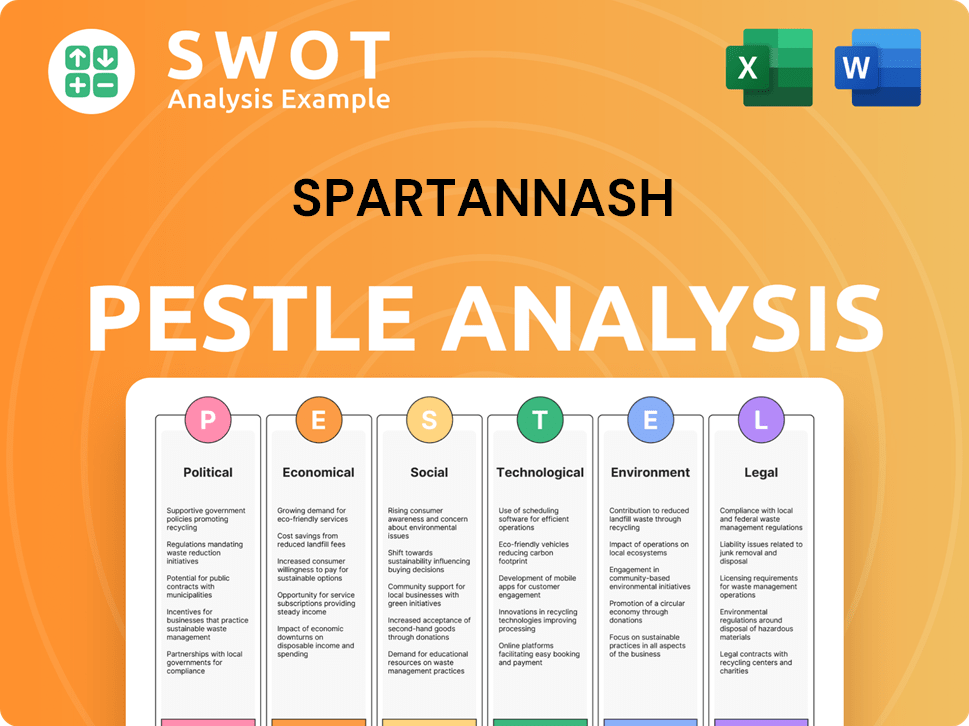
What are the key Milestones in SpartanNash history?
The SpartanNash company has a rich history marked by significant milestones that have shaped its position in the food industry. These achievements reflect the company's growth and strategic adaptations over time, including key acquisitions and expansions that have solidified its market presence.
| Year | Milestone |
|---|---|
| 2013 | Merger of Spartan Stores and Nash Finch Company, creating a larger food solutions company. |
| Ongoing | Largest distributor by revenue to military commissaries. |
| 2024 | 'Margin-enhancing initiatives' contributed nearly $50 million in benefits. |
Innovations at SpartanNash focus on enhancing supply chains and retail experiences. The company has invested in store remodels, convenience store growth, and expanding its ethnic store footprint, such as Supermercado Nuestra Familia locations.
SpartanNash continuously refines its supply chain to improve efficiency and reduce costs. This includes optimizing distribution networks and leveraging technology to track and manage inventory more effectively.
The company is investing in store remodels to enhance the shopping experience. These upgrades include modern layouts, updated decor, and improved product displays to attract and retain customers.
SpartanNash is growing its presence in the convenience store sector. This involves opening new locations and adapting existing stores to meet the needs of on-the-go consumers.
The company is increasing its presence in ethnic markets, such as the Supermercado Nuestra Familia locations. This expansion caters to diverse communities and offers specialized products.
SpartanNash is exploring the use of AI to streamline operations and enhance customer experiences. This includes using technology for inventory management and personalized marketing.
These initiatives have generated nearly $50 million in benefits in fiscal year 2024, with cumulative benefits reaching $130 million since 2021. These efforts focus on improving profitability through various operational efficiencies.
Challenges for SpartanNash include market downturns and competitive pressures. The wholesale segment saw a 2.6% decline in net sales in Q1 2025, while net earnings decreased to $2.1 million from $13.0 million in Q1 2024.
The wholesale segment experienced a 2.6% decrease in net sales in Q1 2025. This decline was primarily due to reduced case volumes, indicating challenges in this area of the business.
Net earnings dropped significantly in Q1 2025, falling to $2.1 million from $13.0 million in Q1 2024. This decrease was influenced by factors like increased depreciation, amortization, and restructuring expenses.
SpartanNash has faced market share losses, particularly in its retail segment. The company is responding with strategies to regain and grow its customer base.
A new Consumer Value Proposition is being implemented, focusing on store modernization and price reductions on 6,000 items. This strategy aims to attract customers by offering better value and a more appealing shopping environment.
SpartanNash has undergone corporate restructuring, including eliminating an unspecified number of positions. This restructuring aims to streamline operations and position the company for growth.
The retail and distribution sectors face ongoing competitive pressures. SpartanNash is continuously adapting its strategies to stay competitive in the market.
SpartanNash Business Model Canvas
- Complete 9-Block Business Model Canvas
- Effortlessly Communicate Your Business Strategy
- Investor-Ready BMC Format
- 100% Editable and Customizable
- Clear and Structured Layout
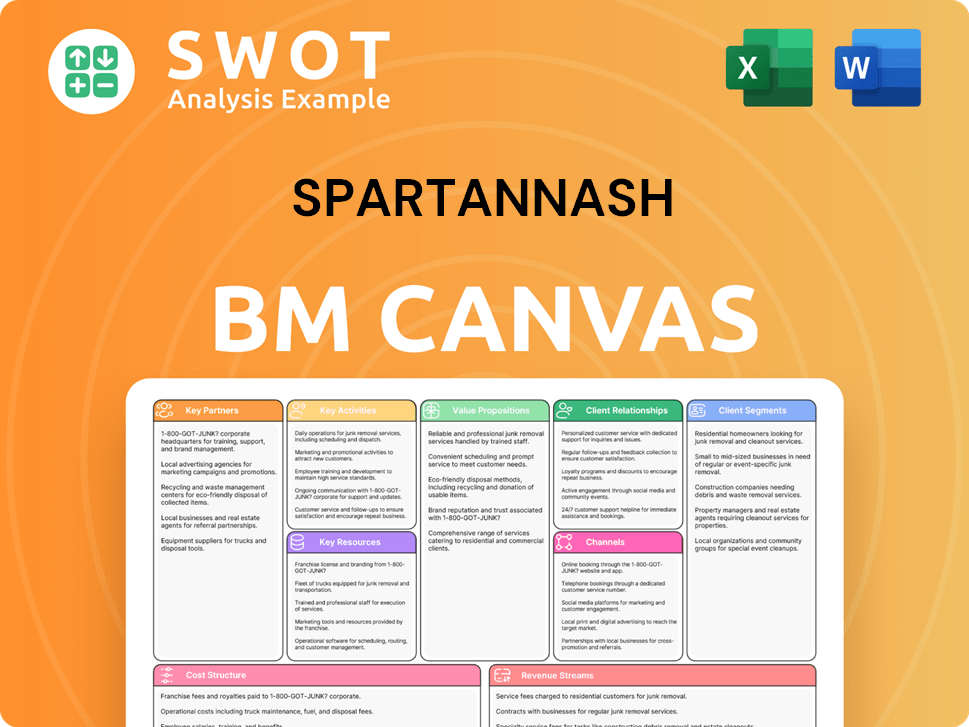
What is the Timeline of Key Events for SpartanNash?
The SpartanNash company has a rich history, evolving from a wholesale grocery company to a significant player in the grocery and food distribution sectors. The company's journey includes strategic mergers, acquisitions, and expansions that have shaped its current operations and future outlook.
| Year | Key Event |
|---|---|
| 1917 | Spartan Stores was founded as Grand Rapids Wholesale Grocery Company. |
| 1918 | Forty-three retailers signed Articles of Incorporation for Grand Rapids Wholesale Grocery Company; the first purchase was a boxcar of sugar. |
| 1973 | Spartan Stores converted to a for-profit business corporation. |
| 1983 | Nash Finch Company became a publicly traded company. |
| 1995 | Nash Finch acquired Military Distributors of Virginia (MDV), expanding its military distribution. |
| 2000 | Spartan Stores became publicly traded on the NASDAQ (SPTN) and acquired Seaway Food Town. |
| 2013 | Spartan Stores and Nash Finch Company merged to form SpartanNash. |
| 2017 | SpartanNash acquired Caito Foods and SpartanNash Logistics. |
| 2024 | SpartanNash acquired regional grocery chains Metcalfe's Market and Fresh Encounter, as well as convenience store operator Markham Enterprises. |
| 2024 (Q4) | Private-label penetration exceeded 27%. |
| 2025 (Q1) | Net sales increased by 3.7% to $2.91 billion; retail segment sales grew by 19.6%. |
| 2025 (May) | SpartanNash opened its fourth Supermercado Nuestra Familia in Omaha, Nebraska. |
SpartanNash is focused on key strategic initiatives to drive future growth and enhance its market position. The company is committed to investing in its retail segment, expanding in the convenience store sector, and growing its ethnic store footprint. These initiatives are designed to enhance profitability and deliver long-term shareholder value.
The company reaffirmed its fiscal year 2025 guidance, projecting net sales between $9.8 billion and $10.0 billion. Adjusted EBITDA is expected to range from $263 million to $278 million, with adjusted EPS between $1.60 and $1.85. Food-at-home inflation is projected to be around 2% for fiscal year 2025.
SpartanNash plans to continue investing in its retail segment with a focus on 'slight conventional and up-market store remodels.' They are also expanding in the convenience store sector. The company anticipates positive comparable-store sales growth in 2025 through retail improvements and store footprint expansion.
The company is growing its ethnic store footprint by doubling its Hispanic food market presence in 2025. SpartanNash anticipates opening two or three more Supermercado Nuestra Familia stores in the Midwest later in 2025 and one or two in Q1 2026. This expansion reflects a strategic move to cater to diverse communities.
SpartanNash Porter's Five Forces Analysis
- Covers All 5 Competitive Forces in Detail
- Structured for Consultants, Students, and Founders
- 100% Editable in Microsoft Word & Excel
- Instant Digital Download – Use Immediately
- Compatible with Mac & PC – Fully Unlocked
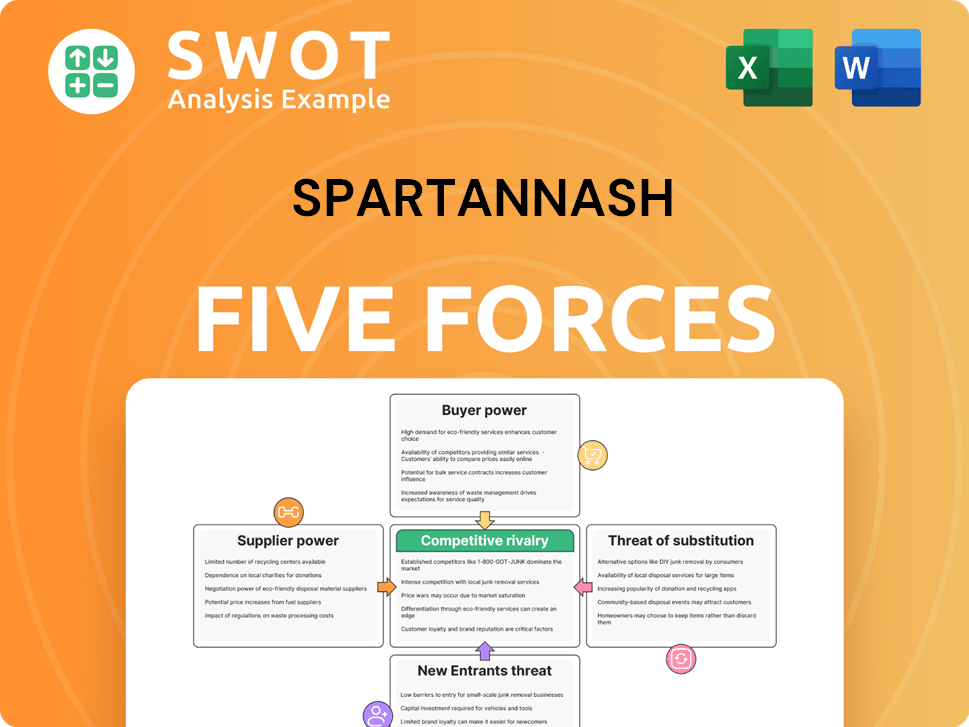
Related Blogs
- What is Competitive Landscape of SpartanNash Company?
- What is Growth Strategy and Future Prospects of SpartanNash Company?
- How Does SpartanNash Company Work?
- What is Sales and Marketing Strategy of SpartanNash Company?
- What is Brief History of SpartanNash Company?
- Who Owns SpartanNash Company?
- What is Customer Demographics and Target Market of SpartanNash Company?
Disclaimer
All information, articles, and product details provided on this website are for general informational and educational purposes only. We do not claim any ownership over, nor do we intend to infringe upon, any trademarks, copyrights, logos, brand names, or other intellectual property mentioned or depicted on this site. Such intellectual property remains the property of its respective owners, and any references here are made solely for identification or informational purposes, without implying any affiliation, endorsement, or partnership.
We make no representations or warranties, express or implied, regarding the accuracy, completeness, or suitability of any content or products presented. Nothing on this website should be construed as legal, tax, investment, financial, medical, or other professional advice. In addition, no part of this site—including articles or product references—constitutes a solicitation, recommendation, endorsement, advertisement, or offer to buy or sell any securities, franchises, or other financial instruments, particularly in jurisdictions where such activity would be unlawful.
All content is of a general nature and may not address the specific circumstances of any individual or entity. It is not a substitute for professional advice or services. Any actions you take based on the information provided here are strictly at your own risk. You accept full responsibility for any decisions or outcomes arising from your use of this website and agree to release us from any liability in connection with your use of, or reliance upon, the content or products found herein.